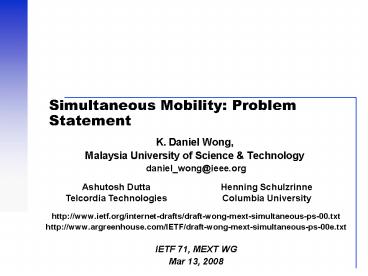Simultaneous Mobility: Problem Statement - PowerPoint PPT Presentation
1 / 9
Title:
Simultaneous Mobility: Problem Statement
Description:
Belated arrival (of binding update or other control message) ... that they send to each other are lost through belated arrival, or if one or both ... – PowerPoint PPT presentation
Number of Views:53
Avg rating:3.0/5.0
Title: Simultaneous Mobility: Problem Statement
1
Simultaneous Mobility Problem Statement
- K. Daniel Wong,
- Malaysia University of Science Technology
- daniel_wong_at_ieee.org
- http//www.ietf.org/internet-drafts/draft-wong-mex
t-simultaneous-ps-00.txt - http//www.argreenhouse.com/IETF/draft-wong-mext-s
imultaneous-ps-00e.txt - IETF 71, MEXT WG
- Mar 13, 2008
Ashutosh Dutta Telcordia Technologies
Henning Schulzrinne Columbia University
2
Simplified Concept of Simultaneous Mobility
Domain A2
Domain A1
Domain B1
Domain B2
A (2nd)
A (1st )
B (1st )
B (2nd)
IP Data traffic
Binding update
binding update
Both binding updates are lost
3
Definitions
- Communication Session
- Two Mobile Hosts attached to two different points
of attachment in the network are said to be in a
communication session if they are actively
exchanging data. NB We do not attempt to define
here what "actively exchanging data" means. This
may depend on the applications, and may be
related to a timer set since the last received
packet. - Normal state (of a communication session)
- A session is in a normal state when data from one
Mobile Host is arriving at the right location
for the other Mobile Host, and vice versa. - Interrupted state (of a communication session)
- A session is in interrupted state when it is not
in normal state - Handoff
- A handoff is a movement of a Mobile Host from a
previous attachment point to a new attachment
point, such that the old IP address does not
route to the new attachment point, but a new IP
address is needed to route there. NB this is
sometimes known as layer-3 handoff, in contrast
to so-called layer-2 handoff
4
Definitions
- Belated arrival (of binding update or other
control message) - A binding update (or other control message) is
considered to make a belated arrival at a network
if the destination Mobile Host is no longer
attached to that network. - Lost (binding update or other control message)
- A binding update or other control message is lost
if it does not arrive at its intended
destination. A binding update is lost through
belated arrival if it makes a belated arrival and
is consequently lost. A binding update that has
arrived late may also be retrieved by some other
agent in the network without necessarily getting
lost. - Simultaneous mobility problem
- The simultaneous mobility problem occurs when
there are two Mobile Hosts in a communications
session in normal state, and they both move such
that one, or both, of the binding updates that
they send to each other are lost through belated
arrival, or if one or both of the binding updates
do not even get sent because of the loss (through
belated arrival) of some other control message
prior to the sending of binding updates, and such
that the return from interrupted to normal state
is significantly delayed, or never happens.
5
MIPv4 Simultaneous Mobility Flow Diagram
Home Domain B
Home Domain A
Domain A2
Domain A1
Domain B1
Domain B2
A (2nd)
A (1st )
B (1st )
B (2nd)
Home Agent A
Home Agent B
IP Data traffic
register
register
Resumption of IP Data traffic
No problem with simultaneous mobility
6
MIPv6 Simultaneous Mobility Flow Diagram (1 of 2)
Home Domain B
Home Domain A
Domain A2
Domain A1
Domain B1
Domain B2
A (2nd)
A (1st )
B (1st )
B (2nd)
Home Agent A
Home Agent B
IPv6 Data traffic
binding update
binding ack
CTI
HTI
binding update
binding ack
normal correspondent registration for B
As CTI and HTI messages are lost!
7
MIPv6 Simultaneous Mobility Flow Diagram (2 of 2)
Home Domain B
Home Domain A
Domain A2
Domain A1
Domain B1
Domain B2
A (2nd)
A (1st )
B (1st )
B (2nd)
Home Agent A
Home Agent B
IPv6 Data traffic
binding update
binding ack
CTI
HTI
binding update
binding update
binding ack
normal correspondent registration for B
As binding update is lost!
8
SIP
Home Domain 1
Home Domain 2
Domain 2a
Domain 2b
Domain 1a
Domain 1b
MH2 (2nd)
MH1 (1st)
MH2 (1st)
SIP 2 server
SIP 1 server
MH1 (2nd)
INVITE
IP2a
REGISTER
INVITE
OK
RTP Session
re-INVITE
REGISTER
REGISTER
re-INVITE
Both hosts cannot find the other!
9
Conclusion and Discussion
- A definition for simultaneous mobility problem
has been proposed - Specific mobility protocols
- Mobile IPv4 doesnt have the problem
- Mobile IPv6 has the problem
- SIP-based mobility has the problem
- Questions?
- Comments?





























